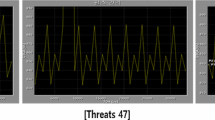Abstract
With radar technology development, WiFi Radar’s application in human-computer interaction, live entertainment, and medical services has gradually deepened. The action recognition technology based on WiFi Radar signal has also attracted a lot of attention. The WiFi Radar sampled signal processing process if Radar sampled signal processing process, the pre-processing, feature extraction training, and classifier selection will cause many action recognition difficulties. In this paper, firstly, during the radar signal’s pre-processing, the clutter signal is removed. Secondly, the CSI mean value, median absolute deviation, and other indicators are applied to extract the action’s signal characteristics. Finally, the feature vector isis trained and classified with the BP neural network, SVM (support vector machine), and Bayesian network to realize human action recognition.
Access this chapter
Tax calculation will be finalised at checkout
Purchases are for personal use only
Similar content being viewed by others
References
Sturman, D.J., Zeltzer, D.: A survey of glove-based input. IEEE Comput. Graph. Appl. 14, 30–39 (1994)
Carmona, P., Pla, F., Salvador Balaguer, E., Javidi, B.: Three-dimensional integral imaging for gesture recognition under occlusions, p. 5 (2018)
Wang, C., Liu, Z., Zhao, J.: Hand gesture recognition based on canonical formed superpixel earth mover’s distance, pp. 1–6 (2016)
Fan, T., et al.: Wireless hand gesture recognition based on continuous-wave doppler radar sensors. IEEE Trans. Microw. Theory Tech. 64, 4012–4020 (2016)
Lien, J., et al.: Soli: ubiquitous gesture sensing with millimeter wave radar. ACM Trans. Graph. 35, 1–19 (2016)
Yang, Z., Zhou, Z., Liu, Y.J.A.C.S.: From RSSI to CSI: Indoor Localization via Channel Response. ACM Comput. Surv. 46(2), 1–32 (2013)
Adib, F., Katabi, D.: See through walls with WiFi!, 08 January 2013
Pu, Q., Jiang, S., Gollakota, S.: Whole-Home Gesture Recognition Using Wireless Signals (Demo), pp. 485–486 (2013)
Guo, L., et al.: A novel benchmark on human activity recognition using WiFi signals, pp. 1–6 (2017)
Li, Y.: Application of wavelet analysis in image denoising and compression. Ph.D., Graduate School of Chinese Academy of Sciences (Changchun Institute of Optics, Precision Machinery and Physics) (2006). (in chinese)
Mei, N., Qian, F., Yan, L., Li, W.: Energy efficiency prediction of screw chillers on BP neural network optimized by improved genetic algorithm. In: 2018 International Computers, Signals and Systems Conference (ICOMSSC), pp. 527–531 (2018)
Lawi, A., Aziz, F.: Classification of credit card default clients using LS-SVM ensemble. In: 2018 Third International Conference on Informatics and Computing (ICIC), pp. 1–4 (2018)
Ohba, T., Arakawa, S., Murata, M.: Bayesian-based virtual network reconfiguration for dynamic optical networks. IEEE/OSA J. Opt. Commun. Netw. 10(4), 440–450 (2018)
Killick, R., Fearnhead, P., Eckley, I.A.: Optimal detection of changepoints with a linear computational cost. J. Am. Stat. Assoc. 107, 1590–1598 (2012)
Lavielle, M.: Using penalized contrasts for the change-point problem. Sig. Process. 85, 1501–1510 (2005)
Acknowledgement
This work was supported in part by the New Engineering Research Project Construction of Electronic and Electrical Practice Education System and Practice Platform Oriented to New Engineering of Fujian University of Technology (under Grant No. E3300017), and in part by the Scientific and Technological Project of Fujian University of Technology (under Grant No. GY-H-21008).
Author information
Authors and Affiliations
Editor information
Editors and Affiliations
Rights and permissions
Copyright information
© 2021 The Author(s), under exclusive license to Springer Nature Switzerland AG
About this paper
Cite this paper
Dong, J., Zhang, L., Ling, Y., Lu, J., Cai, Z. (2021). Action Recognition Using WiFi Radar Signal Characteristics. In: Hassanien, A.E., et al. Proceedings of the International Conference on Artificial Intelligence and Computer Vision (AICV2021). AICV 2021. Advances in Intelligent Systems and Computing, vol 1377. Springer, Cham. https://doi.org/10.1007/978-3-030-76346-6_47
Download citation
DOI: https://doi.org/10.1007/978-3-030-76346-6_47
Published:
Publisher Name: Springer, Cham
Print ISBN: 978-3-030-76345-9
Online ISBN: 978-3-030-76346-6
eBook Packages: Intelligent Technologies and RoboticsIntelligent Technologies and Robotics (R0)




